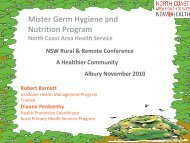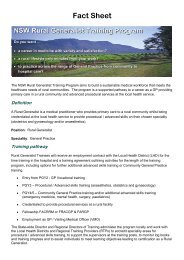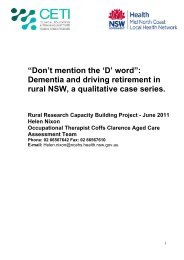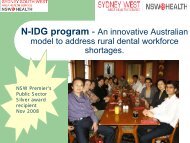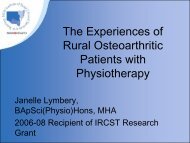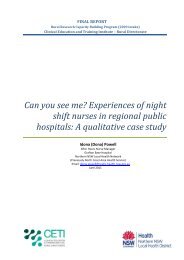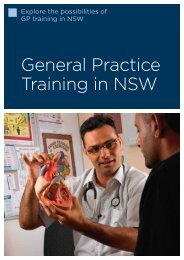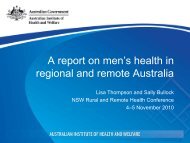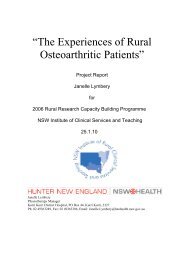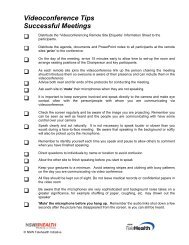Full Report - Home - Health Education and Training Institute
Full Report - Home - Health Education and Training Institute
Full Report - Home - Health Education and Training Institute
Create successful ePaper yourself
Turn your PDF publications into a flip-book with our unique Google optimized e-Paper software.
Context<br />
The MST was implemented in all Upper Hunter hospitals in early 2007. The aim of<br />
including the MST is to ensure that all patients admitted to hospital in the Upper<br />
Hunter Cluster (excluding patients under 60 years of age, Intensive Care Unit (ICU),<br />
mental health patients <strong>and</strong> patients with hospital admission less than 48 hours) are<br />
screened for their risk of malnutrition, <strong>and</strong> a clinically appropriate intervention is<br />
implemented for each patient identified with increased malnutrition risk.<br />
This research was initiated due to the low referral rates received by the APD from<br />
Upper Hunter hospitals for patients with malnutrition. Following an audit at two<br />
hospital sites it was noted that MST completion rates were poor. With studies<br />
showing the incidence of malnutrition for elderly hospital patients in Australia being<br />
5-6,9,12,14,16,18-21<br />
12-55%<br />
a possible explanation was that large numbers of<br />
malnourished patients in Upper Hunter hospitals were not being identified with<br />
malnutrition <strong>and</strong> as a result, not receiving appropriate MNT while in hospital.<br />
In current practice in the selected study hospitals the APD sees patients with<br />
malnutrition very regularly, but who have not been previously identified through the<br />
use of a malnutrition screening tool even though they may have been hospitalised for<br />
some time already. They are often referred towards the end of hospital stay or not<br />
seen during admission at all. Being missed on the screen means their length of stay<br />
is potentially longer, their rehabilitation period lengthens, they experience more<br />
medical complications directly due to malnutrition <strong>and</strong>/or they need to have more<br />
costly care or medical procedures.<br />
For best patient care <strong>and</strong> outcomes, it is therefore important to quickly identify <strong>and</strong><br />
act on any patients admitted with malnutrition.<br />
This study aimed to determine whether the new malnutrition screening procedure of<br />
adding the MST score to the nursing ward list <strong>and</strong> APD contacting the wards for MST<br />
scores would improve malnutrition screening rates <strong>and</strong> MNT interventions for these<br />
malnourished patients.<br />
Approach<br />
The study was a time series design to assess the impact in malnutrition screening on<br />
practice before <strong>and</strong> after the intervention. Five Hospitals within Upper Hunter Cluster<br />
were used as sites to recruit participants. These were Denman, Merriwa, Murrurundi,<br />
Muswellbrook <strong>and</strong> Scone Hospitals.<br />
The pre-intervention <strong>and</strong> post-intervention groups had the same measurements<br />
performed. These were MST score performed by nursing staff, nutritional status<br />
assessed using the Subjective Global Assessment (SGA) <strong>and</strong> supplement provision<br />
for participants monitored by researcher.<br />
The intervention involved education for nursing staff on the change in practice of<br />
MST protocol in which MST score was added to nursing ward list <strong>and</strong> the dietitian<br />
contacting the ward daily to obtain MST score. Data was collected <strong>and</strong> analysed for<br />
76 people in the pre-intervention group <strong>and</strong> 66 people in the post-intervention group.<br />
Chi-square analysis was used to determine association between selected variables.<br />
Shaun Seldon: Research <strong>Report</strong> June 2009 8



